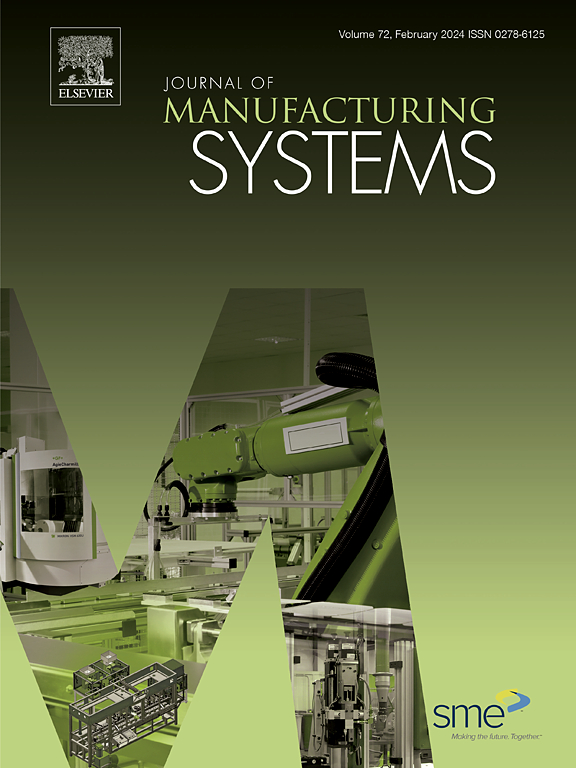先进制造过程监测中传感器数据的无监督多模态融合
IF 12.2
1区 工程技术
Q1 ENGINEERING, INDUSTRIAL
引用次数: 0
摘要
有效地监控生产过程对于保持产品质量和操作效率至关重要。现代制造环境通常会产生大量互补的多模态数据,包括来自不同角度和分辨率的视觉图像、高光谱数据和机器健康监测信息(如执行器位置、加速度计读数和温度测量)。然而,融合和解释这些复杂的高维数据提出了重大挑战,特别是当标记数据集不可用或不切实际时。本文提出了一种基于对比语言-图像预训练(CLIP)模型的制造过程多模态传感器数据融合新方法。我们利用对比学习技术来关联不同的数据模式,而不需要标记数据,克服了传统监督机器学习方法在制造环境中的局限性。我们提出的方法展示了处理和学习五种不同模式的编码器的能力:视觉图像、音频信号、激光位置(x和y坐标)和激光功率测量。通过将这些高维数据集压缩到低维表示空间中,我们的方法促进了下游任务,如过程控制、异常检测和质量保证。该方法的无监督性质使其广泛适用于各种制造领域,其中大量未标记的传感器数据很常见。我们通过一系列实验来评估我们的方法的有效性,证明了它在先进制造系统中提高过程监控能力的潜力。该研究为多模态数据融合提供了一个灵活的、可扩展的框架,可以适应不同的制造环境和传感器配置,从而为智能制造领域做出了贡献。提出的方法为复杂制造过程中更稳健、数据驱动的决策铺平了道路。本文章由计算机程序翻译,如有差异,请以英文原文为准。
Unsupervised multimodal fusion of in-process sensor data for advanced manufacturing process monitoring
Effective monitoring of manufacturing processes is crucial for maintaining product quality and operational efficiency. Modern manufacturing environments often generate vast amounts of complementary multimodal data, including visual imagery from various perspectives and resolutions, hyperspectral data, and machine health monitoring information such as actuator positions, accelerometer readings, and temperature measurements. However, fusing and interpreting this complex, high-dimensional data presents significant challenges, particularly when labeled datasets are unavailable or impractical to obtain. This paper presents a novel approach to multimodal sensor data fusion in manufacturing processes, inspired by the Contrastive Language-Image Pre-training (CLIP) model. We leverage contrastive learning techniques to correlate different data modalities without the need for labeled data, overcoming limitations of traditional supervised machine learning methods in manufacturing contexts. Our proposed method demonstrates the ability to handle and learn encoders for five distinct modalities: visual imagery, audio signals, laser position (x and y coordinates), and laser power measurements. By compressing these high-dimensional datasets into low-dimensional representational spaces, our approach facilitates downstream tasks such as process control, anomaly detection, and quality assurance. The unsupervised nature of our method makes it broadly applicable across various manufacturing domains, where large volumes of unlabeled sensor data are common. We evaluate the effectiveness of our approach through a series of experiments, demonstrating its potential to enhance process monitoring capabilities in advanced manufacturing systems. This research contributes to the field of smart manufacturing by providing a flexible, scalable framework for multimodal data fusion that can adapt to diverse manufacturing environments and sensor configurations. The proposed method paves the way for more robust, data-driven decision-making in complex manufacturing processes.
求助全文
通过发布文献求助,成功后即可免费获取论文全文。
去求助
来源期刊

Journal of Manufacturing Systems
工程技术-工程:工业
CiteScore
23.30
自引率
13.20%
发文量
216
审稿时长
25 days
期刊介绍:
The Journal of Manufacturing Systems is dedicated to showcasing cutting-edge fundamental and applied research in manufacturing at the systems level. Encompassing products, equipment, people, information, control, and support functions, manufacturing systems play a pivotal role in the economical and competitive development, production, delivery, and total lifecycle of products, meeting market and societal needs.
With a commitment to publishing archival scholarly literature, the journal strives to advance the state of the art in manufacturing systems and foster innovation in crafting efficient, robust, and sustainable manufacturing systems. The focus extends from equipment-level considerations to the broader scope of the extended enterprise. The Journal welcomes research addressing challenges across various scales, including nano, micro, and macro-scale manufacturing, and spanning diverse sectors such as aerospace, automotive, energy, and medical device manufacturing.
 求助内容:
求助内容: 应助结果提醒方式:
应助结果提醒方式:


